Call Center Analytics & Top Tips To Be More Data-driven

Table of Contents
What Is Call Center Analytics?
Call center analytics is the collection, measurement, and reporting of performance metrics within a contact center.
It tracks call data and agent performance, handling inbound or outbound calls. Common types of analytics include handle time, call volume, customer satisfaction, and hold time.
However, call center analytics is much more than call times. It factors in the human element to influence how calls are handled, including the customer experience itself.
In most cases, call center supervisors can access this data using specialized analytics tools. However, accessing this call center data analytics is often limited to supervisors and team leads. More modern contact centers provide this real-time data to agents so they can mind increasing call volumes.
However, with the right tools and strategy, call data helps you provide exceptional customer experience, boost brand loyalty, and improve efficiency across the board.
To harness the power of call center analytics, you need to apply them to real-world business challenges. Behind each of the various metrics and key performance indicators (KPIs) are human motivations, interests, and needs.
As you expand the role of your omnichannel contact center, you’ll want to measure your team’s performance so they can ensure total customer satisfaction.
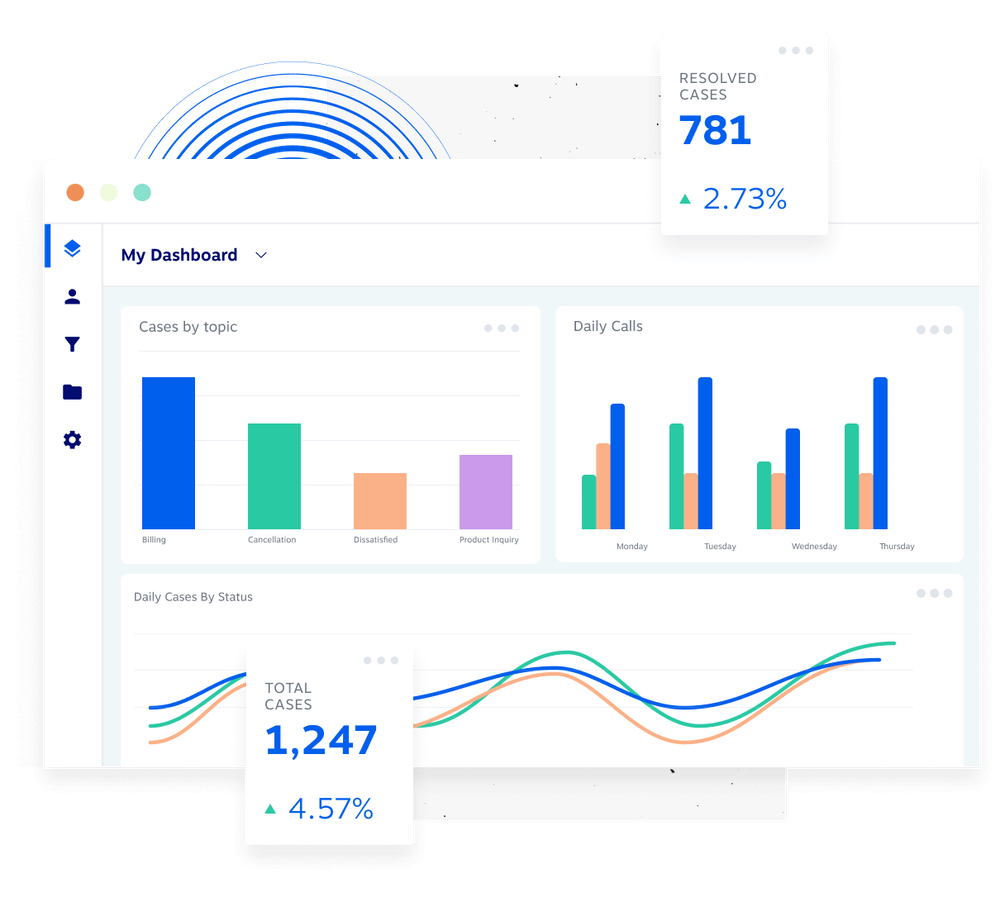
Types of Call Center Analytics
First, the good news. There is a ton of call data available. Everything from call time, first call resolution, and speech analytics. If you can measure a data point, you deliver a better customer experience.
Now, the bad news. You need to package it in such a way that you and your team don’t get overwhelmed. For example, instead of tracking 20 different metrics, focus on the top five that matter most.
Tip: Look for premade templates that come with your call center software to save time.
Depending on the size of your call center and support team, you could be collecting anywhere from a few hundred to millions of minutes of call time a day.
Let’s start with a look at the different analytics available to you:
Business intelligence
Customer relationship data such as revenue, churn risk, and past touchpoints tell your team members about the business value of the customer. These are useful so call center agents can understand the customer journey and even tailor their interaction around these actionable insights.
Interaction analytics
Interactions include real-time and historical data on how your contact center is performing. For example, response and hold times, abandoned calls, resolution time, and call transfer rate. Interaction analytics are great for identifying trends but can also be viewed individually to track agent performance.
Speech analytics
Call center speech analytics track positive and negative keywords said in customer conversations scraped from call recordings. While in the past, speech insights required a team to listen to and analyze hundreds of hours of conversations, today, you can automate the process with conversational artificial intelligence (AI) and machine learning.
Customer surveys
Post-call surveys are another powerful data source to complement the rest of your analytics. Automatically send satisfaction surveys to gauge net promoter scores (NPS)and customer satisfaction scores (CSAT) and understand how your customers felt about their recent experience. Even the survey completion itself is a measure of customer engagement.
Predictive analytics
While most data shows what previously happened, call center predictive analytics tell you what will happen next. This type of call center analytics acts as a crystal ball for customer support.
You can forecast staffing to become more efficient by analyzing historical data and applying forward-looking models. For example, you could look at your call volume report and match your team’s schedule to the days and times when you’re busiest.
Pros and Cons of Using Call Center Analytics
The benefit of analyzing calls is that you can scale your call center operation and achieve consistency. But over time, call center analytics has earned a mixed reputation.
Traditional call centers might still be measured by pure call times, handle times, and hold time alone.
Here are some pros and cons of using call center analytics.
| Pros | Cons |
|---|---|
| Measurable: Numbers are easier to quantify than soft skills like “attitude.” There are dozens of meaningful metrics to track and interpret. | Impersonal: Metrics, unlike the callers themselves, aren’t personalized to the customer needs at hand. Some call center performance metrics discourage building rapport. |
| Integrated: Most cloud contact center solutions offer built-in call center analytics. This means call center managers don’t need to learn SQL or use Crystal Reports. | Isolated: Inbound call trends tend to stay relevant only within a contact center. The downside is that management may be distant from the root causes of customer issues. |
| Manageable: The ideal contact center analytics are actionable. For instance, ones that can be improved by practicing the right behaviors. | Manipulated: Many call center veterans know how to shorten calls at the expense of resolution rates. |
Most challenges with measuring call center analytics and the imperfections involved can be solved with reliable and accurate call center software. Measuring performance isn’t an issue, the quality of your call center service is.
“When performance is measured, performance improves. When performance is measured and reported back, the rate of improvement accelerates.”
Karl Pearson
You just need the right feature set to correctly gauge your performance.
5 Key Analytics Features in Call Center Software
Call center analytics software should make using data more accessible. Not harder. In the era of remote and hybrid work, you need the right communication tools to help you work smarter.
As you compare options, here are five must-have features you need.
1) Data integrations
Your contact center software needs to be tightly integrated with your CRM, team chat, and email. In addition to collecting quality data on agent performance and customer satisfaction, it surfaces valuable insights for your team when they need it most.
Cloud contact centers utilize secure APIs to exchange data with other services behind the scenes.
2) Instant access to call center metrics
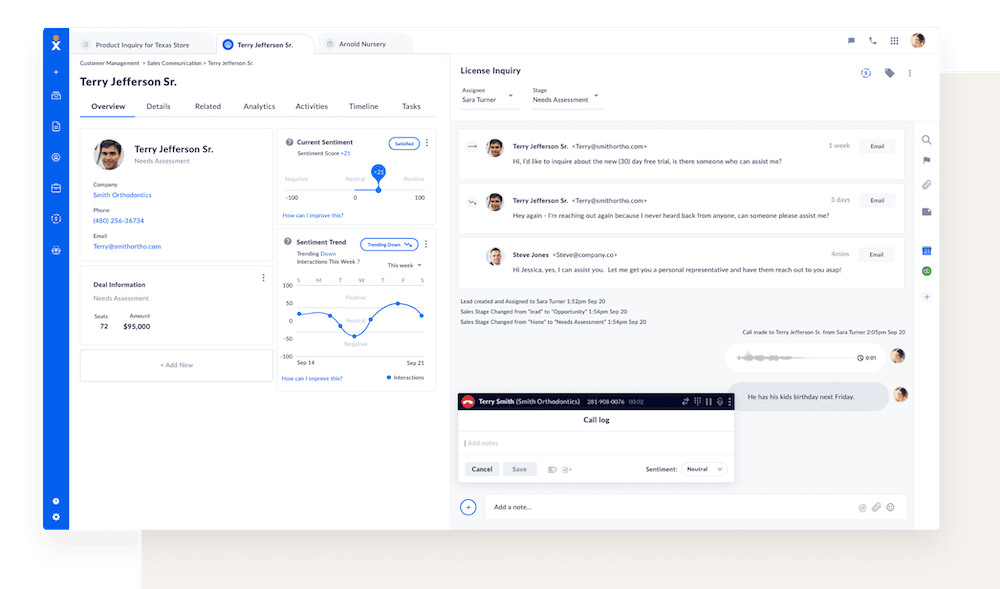
Call data comes in many different forms and can be overwhelming without the right strategy in place. Don’t just store data in a hidden repository. Your analytics software should come with pre-built reports that connect to your most important business metrics.
These reports allow you to quickly turn data into actionable insights rather than struggling to create custom dashboards.
3) Real-time call center analytics for agents and supervisors
It’s no longer enough to only look at historical data. Instead, look for a solution to provide real-time data to enhance the customer experience. These tools aggregate customer sentiment, call center performance, and business outcomes together.
Outside of the call center environment, actionable insights can appear in the form of a CTI-based screen pop when an inbound call arrives at an employee’s phone.
4) Actionable insights along the customer journey
Every business is unique. While reports will help you quickly take advantage of your call data, they might not cover all your KPIs. Use Contact Center as a Service software that can track the performance metrics that matter most to your business goals, such as:
- First Response Time (FRT)
- First Contact Resolution (FCR)
- Average Speed of Answer (ASA)
- Average Handle Time (AHT)
- Call Volume Trends
- Average Waiting Time
Tracking these metrics along the customer journey ensures you create a customer success process. Go beyond customer calls to achieve deeper customer engagement.
5) Omnichannel approach for customer satisfaction
Lastly, your call center analytics software shouldn’t be siloed from the rest of the business. A good analytics solution combines cross-channel analytics and takes advantage of an omnichannel approach.
Look for an intelligent solution that integrates with your other contact center data, such as:
- Text analytics from live chat, SMS, and mobile apps.
- Interactive voice response input and AI responses.
- Customer survey responses, including post-call satisfaction surveys.
- Marketing data from campaigns, emails, and website visits.
- Sentiment scores from chat and phone conversations.

The more customer data you can bring together, the easier it is to create automated workflows and provide amazing service that puts you above the competition.
How Call Center Data Improves Customer Experience
Each piece of data you collect is like a piece of a puzzle. Individually, they don’t offer much value. But when put together, you get a complete picture of the customer journey.
Phone call data is most useful when sharing the results with your team, and call center agents can act on it.
While some analytics software lets you build custom dashboards, it’s a good idea to start with templated reports that make critical metrics easy to understand.
Tracking agent performance
Call center supervisors can use specific reports to check in on one or more agents, find bottlenecks, and identify areas for coaching.
For example, digging into the average handle time by skill report can show if they’re taking longer than average to reach a resolution and need coaching.
Here are a few other standard reports you can use to improve call center agents’ performance:
- Calls by skill report: If you use an automatic call distributor (ACD) for routing inbound calls, you can see the kinds of calls they take. It’s a great way to highlight high-performers and identify additional call queues.
- Agent summary reports: Sometimes, you just need an overall view of an agent’s performance. The summary report covers metrics around the average and longest times spent on various types of calls.
- Activity reports: Keeping track of agent productivity is never easy, especially if you’re working remotely. The activity report gives you a historical view of each agent’s call activity, dispositions, and time spent in different call states.
For routing inbound calls, you can see the kinds of calls they take. It’s a great way to highlight high performers and identify additional gaps.
Improving customer relationship
Call reports can also assess broader trends with a call center’s performance. Even when agents aren’t talking to customers, you should monitor that.
For example, the abandonment rate is the percentage of callers that hang up before reaching an agent. In some cases, this is a good thing, like after hearing the hours of operation or the address in the IVR.
But, for most, an abandonment rate of less than 10% is the industry average.
In that case, you might choose to make ‘speed of answer’ your primary metric.
Here are a few more call center reports you can use:
- Incoming calls report: Customers expect a swift response when they call. This report shows historical and real-time customer data on how you’re handling incoming calls, including wait times, queued, and missed calls.
- Service level report: It’s not always easy to know where your support team is missing the mark. The service level report shows how well your contact center can answer a percentage of calls within the defined period. Industry example: 85/30 means 85% of calls are answered within 30 seconds.
- Summary report: Think of this as a health check for a cloud contact center. The summary report can show your average wait time, abandonment rate, speed of answer, and occupancy rate.
For more guidance, Forrester does a nice job of breaking down the different customer experience (CX) metrics and how you should contextualize them in this diagram.
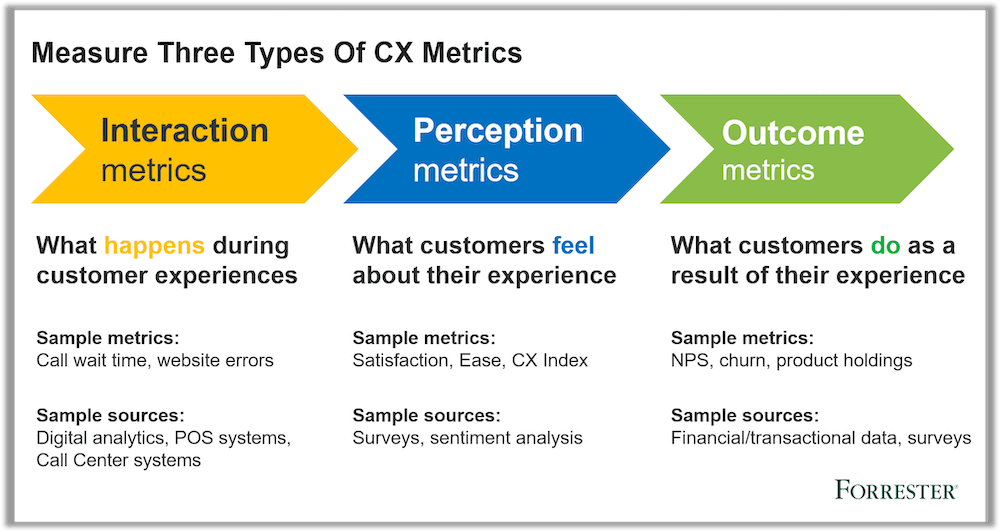
Act on customer data in real-time
So far, most of these call center analytics aggregated weekly and monthly. Today, agents can turn a mediocre phone call into an outstanding customer experience.
How? It’s all about real-time customer sentiment. In particular, agents can view and act on survey responses, unresolved requests, and other customer journey data on the account.
With the functionality of cloud phone systems, you can use real-time data for significant customer service improvements— even if you don’t work in a call center.
Employees can view such actionable insights such as:
- Past purchases
- Customer satisfaction score
- Customer effort score
- Customer revenue
- Account tenure/age
- IVR key presses
- Recent support inquiries
- Preferred contact method (email, phone, social media)
- Order preferences (shirt size, flavor, method of payment)
- Self-service attempts
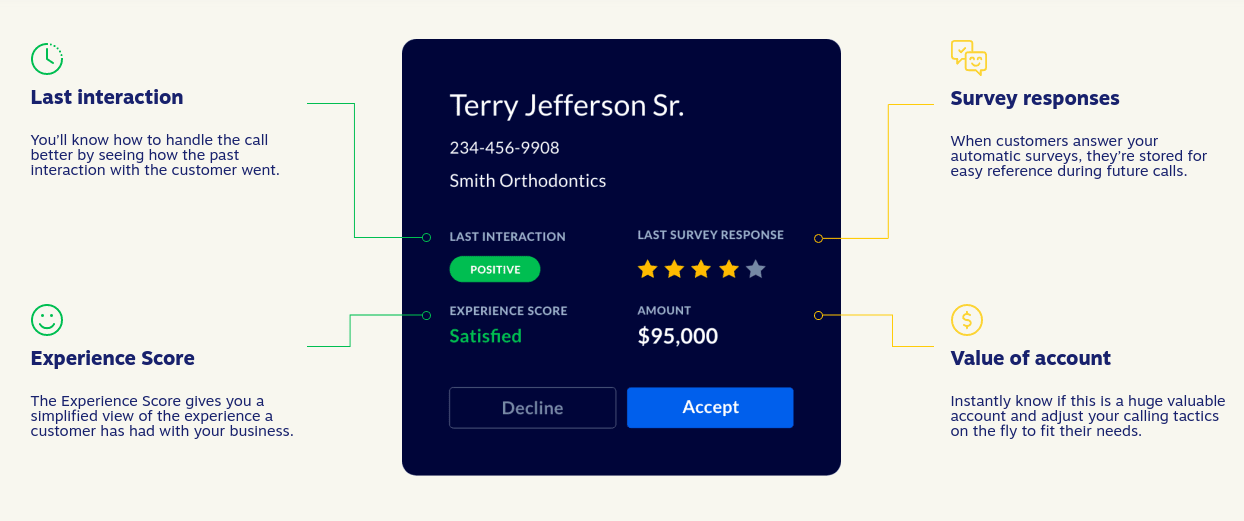
How To Analyze Call Center Data
The truth is that collecting data about your customers is relatively easy. But using that data in a meaningful way is much more challenging.
Not everyone is savvy in using data to scale the business. Research compiled by HBR shows that 72% of companies are falling behind in building a data-led culture.
Half of the problem is technology. Legacy phone systems make it almost impossible to collect and analyze call data properly. However, that’s rapidly changing as more teams switch to cloud-based business phone systems like Nextiva.
Acting on data analytics
Making sense of analytics in a call center comes down to these three phases:
- Collection: Storing data from your contact center. For example, it can be near impossible for call center agents to track resolution rates, so keeping this in your CRM or analytics software improves its fidelity.
- Analysis: Organizing and making reports understandable for your team. Using templates is a great way to enhance business intelligence and keep everyone on the same page.
- Action: Using these data-driven insights to optimize agent performance. Documenting benchmarks and measuring customer satisfaction is key to sustainable growth.
Data without organization and an actionable plan is just noise. While making business decisions based on flawed data is a waste of your time. Ensure that you have a fully integrated cloud call center, so you don’t make the wrong moves.
Each step needs careful consideration to get the most benefit.
Four steps to becoming savvy with data
- Start with a clear vision and strategy – Know which insights are most important and why. Do you want to reduce the average handle time? Or use predictive analytics to improve customer experience? Don’t just bombard your team with reports and data points without connecting them to business goals.
- Get the resources you need to analyze data – Pick software that is intuitive and easily accessed by your entire team. If Tableau analytics software is too steep, give PowerBI a shot. Otherwise, stick with your call center analytics. We’ve outlined some ‘must-have’ features below.
- Make sure your team is ready to act on the data – Don’t flood your team’s inboxes with boring spreadsheets. Deliver the data in an exciting, simple way. Leverage custom wallboards to surface real-time call center data.
- Embrace a culture of objective decision-making – Engage your team in making decisions with data in mind versus instinct. Trust the data. Consider tying bonuses to customer satisfaction and customer retention targets.
Additional Analytics To Improve Business Operations
Of course, calls aren’t the only way your customers get in touch with you.
For those with an omnichannel contact center comprising calls, social media, chat, and email, you’ll have access to even more advanced analytics.
Here are a few more to consider:
Business intelligence
The next level up from call center analytics is tried and true customer intelligence. Business intelligence lets you examine your customer base’s Recency, Frequency, and Monetary (RFM) constructs.
RFM analysis enables you to determine if customers are completing more purchases and generating more revenue. This blends your contact center, payments, and CRM data to aggregate customer behavior.
Text analytics
With more users looking for support through real-time chat, you’re sitting on a goldmine of text-based data. Text analytics collect and analyze conversations and metrics from both live chat and AI-powered chatbots. Use terms and phrases customers already know.
For instance, when giving customers a link to update billing information. So instead of “Update my payment method,” you might want to use “Update my credit card” if that’s what they include in customer service requests.
Self-service analytics
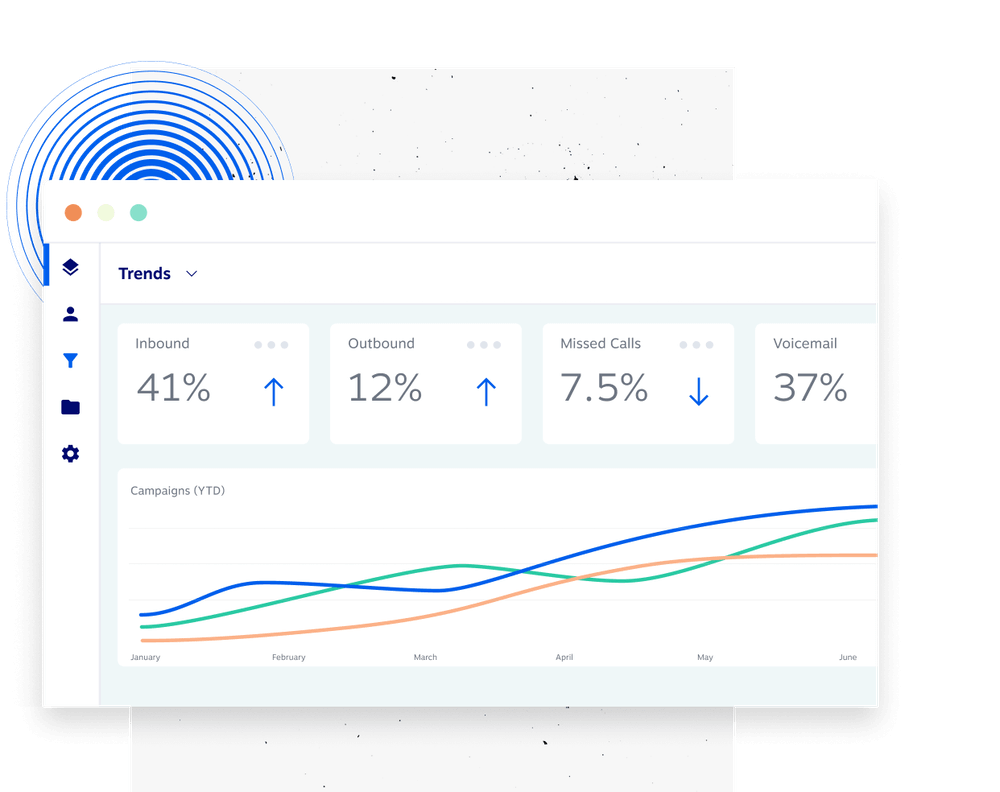
Related to the above, you can mitigate high call volumes with self-service options. The majority of customers will try to resolve issues on their own before reaching out. By collecting data on your most-viewed help docs, you can identify potential problems and give your agents more context about incoming customer calls.
These data sources help you understand your customers better and provide more efficient support. The goal is to turn the data behind your customer interactions into business outcomes: more revenue, higher customer loyalty, and decreased service costs.
Turn Your Contact Center Into a Differentiator
Zappos made a name for itself for being maniacal about customer service. And they lived it and proved it over the years by creating a culture of exceptional customer support. I’d be remiss if I didn’t mention that our Amazing Service is atypical for the UCaaS market.
More than ever, customer experience is becoming the key factor that wins deals and drives customer loyalty — not price. To uncover the “what” and the “why” behind customer calls with the correct data.
Looking ahead, the odds are in your favor. A study by McKinsey suggests that companies embracing call center analytics reduce average call handle time by 40% and optimize conversion rates by almost 50%!
With the right call center solution and a strategy to expedite the decision-making in your company, you’ll be well on your way to standing out from the crowd.






